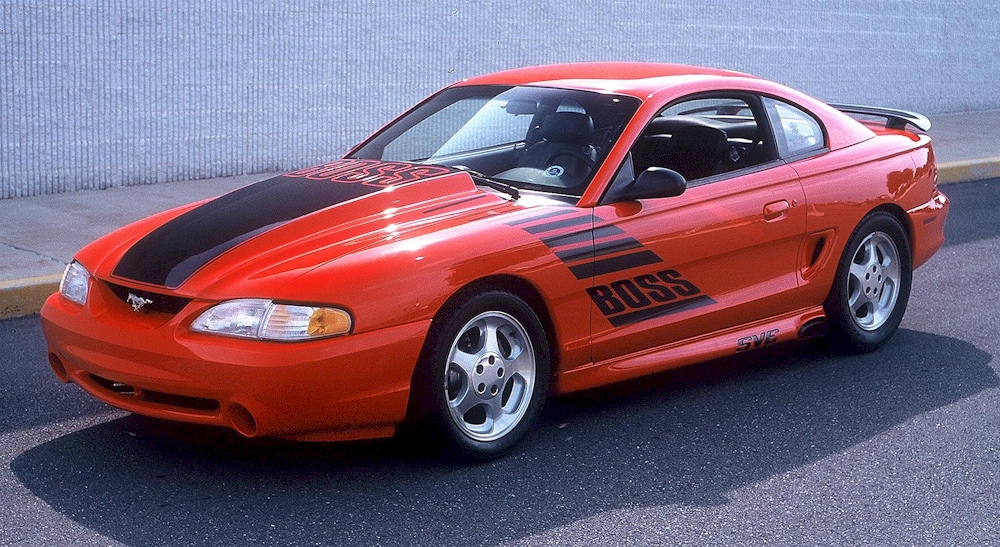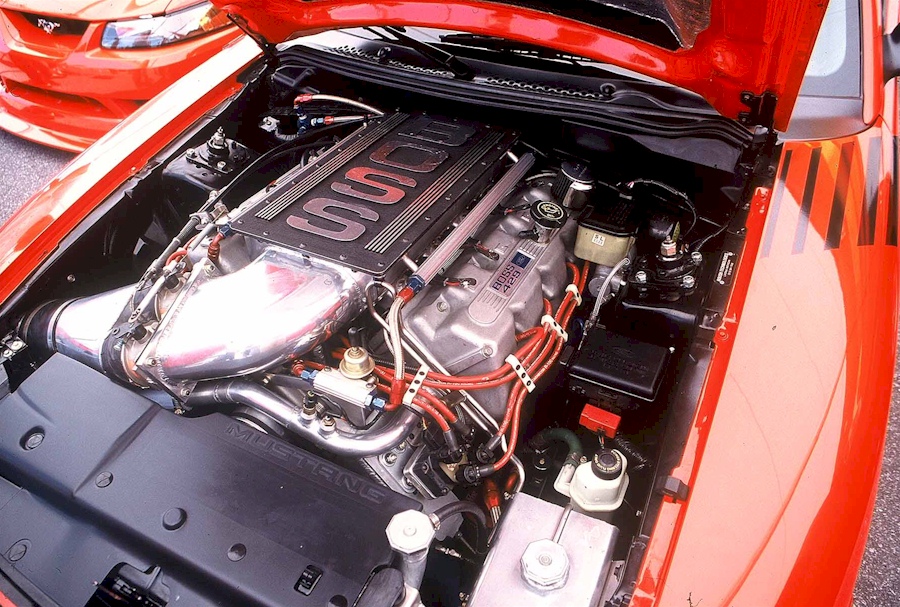Install the TCG app
how_to_install_app_on_ios
follow_along_with_video_below_to_see_how_to_install_our_site_as_web_app

Note: this_feature_currently_requires_accessing_site_using_safari
You are using an out of date browser. It may not display this or other websites correctly.
You should upgrade or use an alternative browser.
You should upgrade or use an alternative browser.
More options
Who Replied?[MENTION=4846]Zack[/MENTION] had a v10 powered marauder
why did Zack disappear?
.

https://www.motortrend.com/cars/ford/mustang/2004/112_0308_ford_mustang_boss_350_v_10/

AMERICAN V-8 POWER: FORD MUSTANG BOSS 350 V 10
Exclusive Test: Whatever you think you see, this car doesn't exist
David Freers photographer, Jack Keebler writerSeptember 22, 2003
The cylinder heads and block are special castings. The oil pan, intake manifold, and 54-degree crank also are one-offs, and control units run each five-hole cylinder bank independently.
Who says a V-8 is the only engine choice for an affordable car that runs 0-60 mph in under 4.5 seconds? Well, nearly any American powertrain engineer will, though the folks at Mitsubishi and Subaru have had a lot to say about that lately. But what would you get if you started with one company’s tried-and-true 4.6-liter/305-horsepower DOHC V-8 residing in a used-up test car destined for the crusher, then added a vivid imagination, some serious know-how, a deep parts bin, a stray company credit card, a tanker load of midnight oil, and, oh yeah, two extra cylinders?
Answer: one of the quickest Mustangs ever built within the walls of Ford Motor Company.
If you do the math, this all-aluminum, DOHC V-10 based on the current Modular 4.6 comes out to be just a smidgen under 351 cubic inches. That’s why this silver rocket-launcher proudly and appropriately wears Boss 351 decals in the best ’71 Mustang tradition. On a chassis dynamometer, its clandestine motor is said to deliver 430 horsepower and 405 lb-ft of torque to the rear wheels. Given the instrumented results from a late-evening test session, as well as the pair of long black tire stripes we left behind, we have no reason to doubt those numbers.
This Xstang and its V-10 engine are so secret and politically charged that the advanced-powertrain engineers and the Ford (in this case, not so) public-relations person who slipped us onto the company’s remote Romeo, Michigan, proving ground insisted they remain anonymous. That’s not to say Ford brass is completely unaware that this car and engine were built.
According to these same sources, Chris Theodore, vice president of North American product development; J Mays, vice president of design; Neil Ressler, retired Ford Motor Co. chief technical officer (now consulting on the GT project); and even William Clay Ford Jr., chairman and CEO, have all experienced a dose of eyeball-flattening V-10 thrust (Bill Ford’s enthusiastic comment is too colorful to quote here). And J Mays liked this engine configuration so much he wrapped a whole car around it. Mays demonstrated Ford’s future-sedan design vocabulary with the 427 Concept, which appeared at the North American International Automobile Show in Detroit this past January. That sedan’s V-10 was a rumbling 7.0-liter DOHC design running high-flow Cobra-R-based cylinder heads.
Why did a handful of rogue engineers at Ford Powertrain build these V-10 engines? Simple: They’re car freaks, just like us. “You could call it an unfunded research project,” offers one of the covert operators, “which can get expensive when you’re on your third T56 manual trans, fifth clutch, second nine-inch rear axle, and third set of rear tires.”
Indeed, this research project’s propensity to gobble driveline pieces is an accounting department’s worst nightmare. There’s simply no column on any Ford corporate spreadsheet headed “351 V-10” or “V-10 Mustang” project. There are no extra dollars to do the full, official development or manufacturing program needed to put this engine into volume production, either. Ford’s SVT/SVE and the Ford Racing shops had nothing to do with it, and this engine is in no way related to the 6.8-liter/310-horsepower SOHC Triton V-10 used in F-250 pickups.
Fortunately, when you work at a major automaker, the parts bin is exceptionally large, and important stray pieces are floating around if you know where to scrounge. This V-10’s pistons, valves, and connecting rods are all shared with the 32-valve 4.6-liter Modular V-8. The camshafts, of course, are custom, but they use the same grind profile as the V-8.
Still, some things had to be fabricated outside of Ford or on the engineers’ own time. For example, the cylinder heads and block are special castings. The oil pan, intake manifold, and 54-degree crank also are one-offs. Fortunately, the accessory belt-drive system is another component borrowed directly from the Modular V-8 family. Since there’s no Ford computer software or electronic hardware for a V-10 of this type, this 351 takes its signals from two blinking dash-mounted control units that run each five-hole cylinder bank independently.
They do a good job of it–most of the time: During a hard deceleration run for the camera, the engine stumbled and quit once. Otherwise, it ran as smoothly as any high-performance production piece approved by the Blue Oval. And then, there’s that noise. The handcrafted V-10 sounds wonderful, firing through two Borla mufflers, two more Dynamax muffs, and 2.5-inch tail pipes. Its voice somewhat reminds us of a big-bore Italian V-12’s, particularly the bass notes issued up when you get heavy into the pedal. And the burble in no way resembles the vacuum-cleaner-like hiss of the early Viper’s V-10. Sometimes things just work out, though two fewer mufflers would be fine by us.
Our test numbers barely reflect the acceleration on tap from this no-name engine-development mule. The BFGoodrich P295/35ZR18 Comp T/As on Saleen wheels were completely overwhelmed by the V-10’s surging Mississippi of torque. On our first two acceleration runs, the rubber went up in smoke–in first, second, and third gears. It’s an unsettling–but big-time fun–feeling to be spooling rear tires and yawing slightly sideways at better than 80 mph.
After we realized that any spin at launch was just burning down the tires and leaving them unhooked until the top of third gear, we tried several frustrating low-rev launches. No good. So the rear tire pressures were dropped significantly to give the contact patches a wider bite. That, of course, added a bit of steering and braking drama at the top of our acceleration runs (about 120 mph) with the end of the guardrail zooming up like a quarter-mile-long can opener.
Finally, we scrabbled out a still-traction-limited 4.4-second blast to 60 and a 12.88/114.44 quarter-mile run. That beats the solid 4.8 to 60 and 13.01 at 110.69 we recently achieved driving an ’03 SVT Cobra with the supercharged 4.6. We’re confident that, with a set of drag slicks, sub-four-second runs to 60, a quarter in the low 12s, and a warped driveshaft are all possible. Perhaps another time.
The chances of this V-10 ever seeing the light of day resemble that of an Anna Nicole Smith presidential bid. At one time, the engine reportedly had a shot at slipping into the back of the exotic Ford GT. But the cool heads at SVT wisely went with a well-proven 5.4-liter V-8 and a supercharger. The original Ford GT was always V-8-powered, anyway, so it all made sense. Still, the tiny stealth team working on the V-10 believes it never got a clear opportunity to understand the GT’s development timing and fairly bid for the job.
On this impassioned underground team’s behalf, we can say its backdoor Boss delivers solid muscle, packages neatly into the Mustang’s engine bay, and sounds badass. Our short experience behind the wheel indicates the engine’s all-aluminum mass doesn’t upset the car’s basic balance much, either. We hammered the gas pedal, as did a long string of Ford test pilots, shredding tires, frying clutches, shattering pinions, and trashing three of the toughest manual gearboxes available for a street car.
Why? Because–in the very best Woodward Avenue tradition–that’s the way it’s done in Detroit, baby.
Mustang Boss 351 V-10 Experimental
Base price Undisclosed to protect the guilty
Price as tested Yo–see above
Vehicle layout Front engine, rwd, 2-door, 5-pass
Engine 5.8L V-10, DOHC, 4 valves/cyl, cast aluminum block & heads
Displacement, ci/cc 350.9/5751
Hp @ rpm 430 @ 6500
Torque @ rpm 405 @ 5500
Transmission 6-speed manual
Curb weight, lb 3565 (est)
0-90 mph 8.3
0-100 mph 10.3
1/4 mile, sec @ mph 12.88 @ 114.44
EPA mpg Who cares?
On sale in U.S. Probably never/X-program one-off
https://www.motortrend.com/cars/ford/mustang/2004/112_0308_ford_mustang_boss_350_v_10/
Yup based on the triton V10 iirc
Nope. That is a bad "performance" based motor due to limited rpm and balance shaft issues or something. I forget now what it was. But ya, not a good engine for a performance type swap.
Nope. That is a bad "performance" based motor due to limited rpm and balance shaft issues or something. I forget now what it was. But ya, not a good engine for a performance type swap.
I was under the imprsesion that the Triton was more of a long stroke, tall decked 4.6L anyways. Maybe I'm utterly wrong on that? I mean, it would make sense this was the short decked version of the 6.8L effectively
Cool engine, I have seen pics of a swapped CV with a 6.8 in it. Musta needed a wicked shoe horn.
I was under the imprsesion that the Triton was more of a long stroke, tall decked 4.6L anyways. Maybe I'm utterly wrong on that? I mean, it would make sense this was the short decked version of the 6.8L effectively
Cool engine, I have seen pics of a swapped CV with a 6.8 in it. Musta needed a wicked shoe horn.
Ya it is a motor built for torque production. The stroke is like 102mm versus 90mm for the 4.6L.
It's an ok engine for a motorhome or work F250/F350. Not worth the cost to make it perform as a high rpm, big hp, engine. Plus the balance shaft issues. Easier swaps that would make more power.
Ford messed up with the close bore spacing and short stroke in their motors. Gearheads can't get big cubes out of them. The style V10 in this car could have given us a lot of potential. Oh well. The Coyote isn't bad and seems highly capable as that new Bertram racecar makes just under 700 hp with it.
Ya it is a motor built for torque production. The stroke is like 102mm versus 90mm for the 4.6L.
It's an ok engine for a motorhome or work F250/F350. Not worth the cost to make it perform as a high rpm, big hp, engine. Plus the balance shaft issues. Easier swaps that would make more power.
Ford messed up with the close bore spacing and short stroke in their motors. Gearheads can't get big cubes out of them. The style V10 in this car could have given us a lot of potential. Oh well. The Coyote isn't bad and seems highly capable as that new Bertram racecar makes just under 700 hp with it.
They've come quite a ways with the Coyote indeed it seems. Not to mention the rods don't seem to chuck themselves out of the blocks near as easy.
I think the biggest obstruction with the V10 is they only ever made 2V and 3V heads. The rest of the parts (rods, pistons, valve train) are readily out there.
Thread Info
-
20Replies
-
3KViews
-
Participants list


